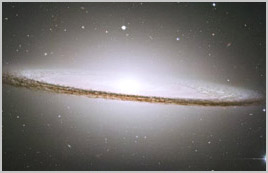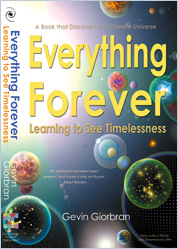 Foreword Foreword
Re-Discovering a Meaningful Universe
The most spiritually and philosophically consequential
law in science is without question the second law of thermodynamics, which
claims that all systems that originate in an ordered state decay into a
disordered state as time evolves. The second law has been written about
extensively but the underlying conclusion which everyone must draw is always the
same. The second law indicates the universe is ultimately meaningless. According
to the second law, the universe is just winding down, because disorder is more
probable. We can find meaning in the present, but the long-term evolution of
the universe has no ultimate purpose or goal. The beautifully ordered universe is
in the process of dying. That conclusion is forced upon every
person who learns it, and in fact the second law hangs over science and humanity
like a black cloud.
Consider if
human history had been different, and we had found instead that the universe is
moving towards increasing order, this giving the universe a kind of innate
purpose or goal, perhaps a goal of perfection, or at least a steady progression
of some kind, imagine how much more interested people would be in
science today. The second law is undoubtedly solely responsible for
undermining the growing interest in science that came about in the 1960's, when
the big bang theory became popular and after
Apollo missions to the moon. Surely
the
modern state of human affairs, even world politics, would be significantly
changed had the news been ultimately good.
Unfortunately, there seems to be no escape from the brutal facts. The second law is one
of the most fiercely defended
laws in science today. And yet, it should be noted, that something totally unexpected occurred in science recently,
something that
promises to radically change how we see the future.
In the summer
of 1999 NASA officials and a team of scientists in a television
broadcast announced one of the most significant discoveries ever made, easily
comparable to when Edwin Hubble first discovered the galaxies are expanding away
from one another. They had further verified a shocking discovery first made
in 1998 by two different groups of astronomers that showed the expansion of the
universe is accelerating. Prior to this
development, the expansion of the universe was believed to
be slowing down, decelerating ever since time began
13.7 billion years ago. Then careful studies measuring the brightness of type Ia supernovas in distant
galaxies revealed the rate of cosmological expansion is no longer in decline.
After slowing for nearly eight billion years, approximately six billion years
ago the deceleration became acceleration. Whatever the future holds, we are
accelerating towards it.
Simply
discovering that it is possible for the expansion of the universe to
accelerate was to put it mildly completely unexpected, and cosmological science
is now in an unprecedented adjustment period. What
does accelerating expansion mean about the future? What does this acceleration
tell us about the direction of time, or the end of time? What kind of future
will this accelerating expansion create? And does this acceleration change the
bleak outlook of the distant future as dictated by the second law?
The
discovery of accelerating expansion was more relief
than surprise for me personally. I wrote three books between 1994 and 1997 all
prior to the '98 discovery explaining that the universe in the distant future will be stretched
flat by expansion, stating clearly in each book that time will reach the temperature of absolute zero, at
which point time ends for the known universe. My estimate in 1994 was that the age of a universe is approximately 120
billion years. I made my conclusions based upon a
grand model of timelessness, the basics of which is presented here at this
website and also in greater detail in my book, Everything Forever: Learning to
See Timelessness. What is essentially a God's eye view of reality, the map
of timelessness I present, comes along with the realization that there are two kinds of order in nature, rather than
simply order and disorder. I am honored to say that my version of the two kinds
of order greatly extends the work of the well known physicist David Bohm, who
was a favorite student and friend of Albert Einstein. One of Bohm's many books
was Wholeness
and the Implicate Order, which explained his concepts of implicate and
explicate orders. To
use Stephen Hawking's analogy of a puzzle in a box, there is one pattern where a
puzzle fits perfectly together in its most ordered state, and each time we shake the box there is another
pattern where the puzzle is broken and disordered. This represents how we see
the universe today, as a broken puzzle that cannot put itself back together
again. The probability for disorder is always greater than order. If one thinks in terms of order and disorder
as Ludwig Boltzmann did when he developed the statistical side of the second law
(and so envision the whole as an overall asymmetry), this is logically true. Disorder is more probable. However, if
instead we think of the cosmos in terms of positives and negatives and neutrals
(and so imagine the whole as having overall symmetry), then this statement is logically and statistically untrue. If swung to one side
a pendulum exists in a state of imbalance. Set free the pendulum swings until it returns to a state of rest or balance. In this way the puzzle
can fit itself together into a perfect state of balance. A simple pendulum unless acted upon will remain forever at rest.
If the perfect puzzle is a state of balance then it will never change. As
Stephen Hawking has said, “What was the initial state of the universe…It can't be flat space. That would remain flat space.” If we
then evaluate the direction of time from this top-down (timeless) perspective
then the greater whole of possibilities is seen as ultimately balanced and
symmetrical, and the perfect puzzle is and always will be the balance of absolute zero. And where do we
find absolute zero? We find zero exactly where we should expect it, in our future, because the universe is like the
swing of a pendulum moving toward balance. Hence in our past we naturally find
imbalance, the extreme of which can be either all positive or all negative. In
very simple terms, there are two kinds of order in nature. A
division of opposites such as positives apart from negatives represents one kind of order, while
the
balance and unity of zero represents another kind of order. The model
of two orders I explain here and in my book extends David Bohm’s concepts of explicate and implicate order into a far more simple and practical description.
It can be shown that our universe is evolving away from one type of order existent in our past toward a whole other type of order present in our future. This honestly provides a
sensible reason for why the cosmos is systematic and orderly rather than disorderly and chaotic. Learning to see the world through the
theory of two orders creates an extremely advanced understanding of the cosmos.
It reveals quite clearly that the second law is completely
wrong in how it portrays the future. The evolving universe is quite
extraordinarily meaningful and does have a goal and a
purpose.
 In all
my writings I explain how and why the greater Universe
is infinite and timeless, supporting the conclusions made by all the greatest
scientists of the past century, including Albert Einstein, Richard Feynman, and David
Bohm, as well as many of the scientists of today, including those bridging the centuries such as Stephen Hawking, string
theorist Brian Greene and Julian Barbour. Although time as we know it begins and ends, the known
universe is like a story in a great book that tells an infinite number of
stories. The greater infinite Universe exists timelessly, it has always existed,
and will always exist. A bit too profound I know to be good hard science but
discovering there are two kinds of order leads to a whole other way of looking at
the universe. In all
my writings I explain how and why the greater Universe
is infinite and timeless, supporting the conclusions made by all the greatest
scientists of the past century, including Albert Einstein, Richard Feynman, and David
Bohm, as well as many of the scientists of today, including those bridging the centuries such as Stephen Hawking, string
theorist Brian Greene and Julian Barbour. Although time as we know it begins and ends, the known
universe is like a story in a great book that tells an infinite number of
stories. The greater infinite Universe exists timelessly, it has always existed,
and will always exist. A bit too profound I know to be good hard science but
discovering there are two kinds of order leads to a whole other way of looking at
the universe.
I hope you
enjoy the read.
Sincerely,
Gevin Giorbran
Last updated January
2008
|



 Foreword
Foreword In all
my writings I explain how and why the greater Universe
is infinite and timeless, supporting the conclusions made by all the greatest
scientists of the past century, including Albert Einstein, Richard Feynman, and David
Bohm, as well as many of the scientists of today, including those bridging the centuries such as Stephen Hawking, string
theorist Brian Greene and Julian Barbour. Although time as we know it begins and ends, the known
universe is like a story in a great book that tells an infinite number of
stories. The greater infinite Universe exists timelessly, it has always existed,
and will always exist. A bit too profound I know to be good hard science but
discovering there are two kinds of order leads to a whole other way of looking at
the universe.
In all
my writings I explain how and why the greater Universe
is infinite and timeless, supporting the conclusions made by all the greatest
scientists of the past century, including Albert Einstein, Richard Feynman, and David
Bohm, as well as many of the scientists of today, including those bridging the centuries such as Stephen Hawking, string
theorist Brian Greene and Julian Barbour. Although time as we know it begins and ends, the known
universe is like a story in a great book that tells an infinite number of
stories. The greater infinite Universe exists timelessly, it has always existed,
and will always exist. A bit too profound I know to be good hard science but
discovering there are two kinds of order leads to a whole other way of looking at
the universe.